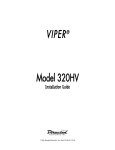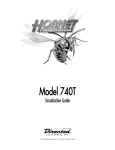Download Automate 425 Installation guide
Transcript
® Model 425 Installation Guide ® © 2001 Directed Electronics, Inc. Vista, CA N425A 3-01 Rev. E 1.1 table of contents What Is Included . . . . . . . . . . . . . . . . . . . . . 3 Installation Points to Remember . . . . . . . . . . 4 Tools Required . . . . . . . . . . . . . . . . . . . . . . . 4 Deciding on Component Locations . . . . . . . . . Siren . . . . . . . . . . . . . . . . . . . . . . . . . . Control Module . . . . . . . . . . . . . . . . . . . . Valet®/Program Switch . . . . . . . . . . . . . . . . Status LED . . . . . . . . . . . . . . . . . . . . . . Optional Starter Kill Relay . . . . . . . . . . . . . 5 5 5 6 7 7 Finding the Wires You Need . . . . . . . . . . . . . . 8 Constant 12V . . . . . . . . . . . . . . . . . . . . . 8 Switched Ignition . . . . . . . . . . . . . . . . . . . 8 Parking Light Wire . . . . . . . . . . . . . . . . . 9 Door Pin Switch Circuit . . . . . . . . . . . . . . 9 Starter Wire . . . . . . . . . . . . . . . . . . . . . 10 Making Your Connections . . . . . . . . . . . . . . . 11 Solderless Butt Connections . . . . . . . . . . . 11 Solder Connections . . . . . . . . . . . . . . . . . 12 Primary Harness (H1), 12-Pin Connector . . . . 13 Primary Harness Wiring Diagram. . . . . . . . . 13 Primary Harness Wire Connection Guide . . . . 13 Door Lock Harness (H2), 3-Pin Connector . . . 18 Door Lock Harness (H2) Wire Connection Guide . 19 Positive-Triggered, Relay Driven Systems (Type A) . . . . . . . . . . . . . . . . . . 19 Negative-Triggered, Relay Driven Systems (Type B) . . . . . . . . . . . . . . . . . . 20 Reversing Polarity (Type C) . . . . . . . . Aftermarket Actuators (Type D) . . . . . Electrically Activated Vacuum (Type E) One-Wire System (Type F) . . . . . . . . . Positive Multiplex (Type G) . . . . . . . . Negative Multiplex (Type H) . . . . . . . . . . . . . . . . . . . . . . . . . . . . . . . 21 21 22 22 23 24 On-board Doubleguard® Shock Sensor . . . . . . 25 Bypassing Sensor Inputs . . . . . . . . . . . . . . . 25 Plug-In Harnesses . . . . . Super Bright LED . . . Valet®/Program Switch Data Input Port . . . . . . . . . . . . . . . . . . . . . . . . . . . . . . . . . . . . . . . . . . . . . . . . . . . . . . . . . . . . . . . . 26 26 26 26 Four-Pin Optional Sensor Harness . . . . . . . . . 26 System Features Learn Routine . . . . . . . . . . Once a Feature is Programmed . . . . . . . . . . To Access Another Feature . . . . . . . . . . . . To Exit the Learn Routine . . . . . . . . . . . . . 27 28 28 28 System Features Menu . . . . . . . . . . . . . . . . . 29 Feature Descriptions . . . . . . . . . . . . . . . . . 29 Transmitter/Receiver Learn Routine . . . . . . . 31 Table of Zones . . . . . . . . . . . . . . . . . . . . . . 32 Rapid Resume Logic . . . . . . . . . . . . . . . . . . 32 Long-Term Event History . . . . . . . . . . . . . . . 33 Troubleshooting . . . . . . . . . . . . . . . . . . . . . 33 Wiring Quick Reference Guide . . . . . . . . . . . 36 Bitwriter™, Car★Com™, Code Hopping™, DEI®, Doubleguard®, ESP™, FailSafe®, Ghost Switch™, Learn Routine™, Nite-Lite®, Nuisance Prevention Circuitry®, NPC®, Revenger®, Silent Mode™, Soft Chirp®, Stinger®, Valet®, Vehicle Recovery System®, VRS®, and Warn Away® are all Trademarks or Registered Trademarks of Directed Electronics, Inc. 2 © 2001 Directed Electronics, Inc. Vista, CA what is included ■ The control module (see diagram) ■ Two 476A remote transmitters ■ A Stinger® Doubleguard® shock sensor on-board the control module ■ A Revenger® Soft Chirp® siren ■ The plug-in status LED ■ The plug-in Valet®/program switch ■ Primary harness ■ Door lock harness Primary Harness Port Shock Sensor Adjustment Door Lock Harness Port 2-Pin Micro LED Port 4-Pin Optional Sensor Port © 2001 Directed Electronics, Inc. Vista, CA Black 3-Pin Data Input Port 2-Pin Mini Blue Valet/Program Port 3 installation points to remember This product represents many years of research and development. It is a sophisticated product that should be installed by experienced security installers only. Please do not attempt installation of this product without reading this guide. The system has been designed to provide the ultimate in security, coupled with limitless convenience and expansion options. This product is not intended for consumer installation and will have NO WARRANTY unless it is installed by an authorized dealer. Do not disconnect the battery if the vehicle has an anti-theft coded radio. If equipped with an airbag, avoid disconnecting the battery if possible. IMPORTANT! Many airbag systems will display a diagnostic code through their warning light after they lose power. Disconnecting the battery requires this code to be erased, a procedure that can require a trip to the dealer. Before beginning the installation: ■ Check with the customer on status LED location. ■ Remove the domelight fuse to prevent accidentally draining the battery. ■ Roll down a window to avoid being locked out of the car. After the install: ■ Test all functions. The “Using Your System” section of the Owner’s Guide is very helpful when testing. ■ When testing, don’t forget that this system is equipped with Nuisance Prevention® Circuitry. NPC™ can bypass both instant trigger zones, making them appear not to work. tools required ■ Digital multi-meter ■ Nutdriver and/or socket set ■ Wire cutters/strippers ■ Panel removal tool ■ Solderless terminal crimpers ■ Drill bit set ■ Cordless power drill ■ Phillips head screwdriver ■ Torx driver set ■ Work light This is a general list of tools required to complete the installation of this DEI® security system in most vehicles. Some vehicles may require additional tools. 4 © 2001 Directed Electronics, Inc. Vista, CA deciding on component locations locations for the siren Some things to remember when mounting the siren: ■ Keep it away from heat sources. Radiators, exhaust manifolds, turbochargers, and heat shields are all things to avoid. ■ Mount it where a thief cannot easily disconnect it, whether the hood is open or shut. Both the siren and its wires should be difficult to find. This usually involves disguising the wire to look like a factory harness. ■ We recommend against grounding the siren to its mounting screws. Instead, we recommend running both the red and black wires into the passenger compartment and grounding to one common point for all devices. After all, both wires are the same length and come already bonded together. Whenever possible, conceal your wires in the factory harnesses or in the same style loom as the factory. ■ When possible, put the siren on the same side of the vehicle as the control module, where its wires will reach the control module’s wires without extending them. Always run the wires through the center of a grommet, never through bare metal! ■ Point the siren down so that water does not collect in it. locations for the control module ■ Never put the control module in the engine compartment! ■ The first step in hot-wiring a vehicle is removing the driver's side underdash panel to access the starter and ignition wires. If the control module is placed just behind the driver's side dash it can easily be disconnected. ■ When locating the control module, try to find a secure location that will not require you to extend the harnesses’ wires (they are 1.5 meters long). Keep it away from the heater core (or any other heat sources) and any obvious leaks. © 2001 Directed Electronics, Inc. Vista, CA 5 ■ The higher the control module is in the vehicle, the better the transmitter range will be. If you put the control module under a seat or inside a metal dashboard, range will suffer. ■ Some good control module locations: Above the glove box, inside the center console, above the underdash fuse box, above the radio, etc. locations for valet/program switch Ensure that the location you choose for the switch has sufficient clearance to the rear. The switch should be well hidden. It should be placed so that passengers or stored items (such as in a glove box or center console) cannot accidentally hit it. The switch fits in a 9/32-inch hole. This system has Remote Valet®. The user can enter and exit Valet® Mode without having to reach the Valet®/Program switch. DEI® introduced this feature so that switch location was less critical in day-to-day use. As long as the Valet®/Program switch can be reached to disarm without a transmitter, easy access is not important. IMPORTANT! When the vehicle is delivered, please show the user where the Valet/program switch is located and how to disarm the system with it. 6 © 2001 Directed Electronics, Inc. Vista, CA locations for the status LED Things to remember when positioning the Status LED: ■ It should be visible from both sides and the rear of the vehicle, if possible. ■ It needs at least 1/2-inch clearance to the rear. ■ It is easiest to use a small removable panel, such as a switch blank or a dash bezel. Remove it before drilling your 9/32-inch hole. ■ Use quick-disconnects near the LED wires if the panel is removable. This allows mechanics or other installers to remove the panel without cutting the wires. optional starter kill relay If the optional Failsafe® Starter Kill Relay or its connections are immediately visible upon removal of the underdash panel, they can easily be bypassed. Always make the relay and its connections difficult to discern from the factory wiring! Exposed yellow butt connectors do not look like factory parts, and will not fool anyone! For this reason, routing the starter kill wires away from the steering column is recommended. © 2001 Directed Electronics, Inc. Vista, CA 7 finding the wires you need Now that you have decided where each component will be located, you’re going to find the wires in the car that the security system will be connected to. IMPORTANT! Do not use a 12V test light to find these wires! All testing described in this manual should be performed using a digital multimeter. obtaining constant 12V We recommend two possible sources for 12V constant: The (+) terminal of the battery, or the constant power supply to the ignition switch. Always install a fuse within 12 inches of this connection. IMPORTANT! Do not remove the fuse holder on the red (H1/11) wire. It ensures that the control module has its own fuse, of the proper value, regardless of how many accessories are added to the main power feed. finding the 12V switched ignition wire The ignition wire is powered when the key is in the run or start position. This is because the ignition wire powers the ignition system (spark plugs, coil) as well as the fuel delivery system (fuel pump, fuel injection computer). Accessory wires, on the other hand, lose power when the key is in the start position to make more current available to the starter motor. How to find (+)12V ignition with your multimeter: 1. Set to DCV or DC voltage (12V or 20V is fine). 2. Attach the (-) probe of the meter to chassis ground. 3. Probe the wire you suspect of being the ignition wire. The steering column harness or ignition switch harness is an excellent place to find this wire. 8 © 2001 Directed Electronics, Inc. Vista, CA 4. Turn the ignition key switch to the run position. If your meter reads (+)12V, go to the next step. If it doesn’t, probe a different wire. 5. Now turn the key to the start position. The meter display should remain steady, not dropping by more than a few tenths of a volt. If it drops close to or all the way to zero, go back to step 3. If it remains steady at (+)12V, you have located an ignition wire. finding a (+) parking light wire The (+) parking light wire is often found near the switch. Many cars have the switch built into the turn signal lever, and in these cars the parking light wire can be found in the steering column. The same wire is often available in the kick panel or running board. How to find a (+) parking light flash wire with your multimeter: 1. Set to DCV or DC voltage (12V or 20V is fine). 2. Attach the (-) probe of the meter to chassis ground. 3. Probe the wire you suspect of being the parking light wire. Usually, the area near the headlight/parking light switch is an excellent area to start, as is the kick panel. 4. Turn on the parking lights. If your meter shows (+)12V, turn off the parking lights and make sure it goes back to zero. 5. If it does return to zero, turn the parking lights back on and, using the dash light dimmer control, turn the brightness of the dash lights up and down. If the meter changes more than a volt when using the dimmer, look for another wire. If it stays relatively close to (+)12V, you have found your parking light wire. finding the door pin switch circuit The best places to find the door switch wire are: ■ At the pin switch: When testing at the pin switch, check the wire to ensure that it “sees” all the doors. Often, the passenger switch will cover all the doors even if the driver’s switch will not. ■ At the dome light: This may not be your best choice if the vehicle has delayed domelight supervision, but it will work in vehicles with completely diode-isolated pin switches. Once you have determined the wire color, the easiest place to connect to the wire is often at the kick panel, at the windshield pillar, or in the running board. When a convenient location is not available, running a wire to the domelight itself is often the best solution. © 2001 Directed Electronics, Inc. Vista, CA 9 How to find a door pin switch trigger wire with your multimeter: 1. Set to DCV or DC voltage (12V or 20V is fine). 2. In most cars, fasten the (+) probe of your meter to (+)12V constant. 3. Probe the wire you suspect of being the door trigger wire. If the meter reads (+)12V when any door is opened, you have found a trigger wire. NOTE: Make sure the wire you use “detects” all the doors! Some newer GM vehicles lack standardtype pin switches. The domelight in these vehicles is turned on when the door handle is lifted. These vehicles usually have a blue/white or white wire coming out of the door into the kick panel which will provide a (-) trigger for all doors. Some GM vehicles (some Cavaliers, Grand Ams, etc.) have a yellow wire coming out of the door which provides a (+) door trigger. finding a starter wire How to find the (+)12V starter wire with your multimeter: 1. Set to DCV or DC voltage (12V or 20V is fine). 2. Attach the (-) probe of the meter to chassis ground. 3. Probe the wire you suspect of being the starter wire. The steering column is an excellent place to find this wire. Remember you do not need to interrupt the starter at the same point you test it. Hiding your starter kill relay and connections is always recommended. 4. Turn the ignition key switch to the start position. Make sure the car is not in gear! If your meter reads (+)12V, go to the next step. If it doesn’t, probe another wire. 5. Cut the wire you suspect of being the starter wire. 6. Attempt to start the car. If the starter engages, reconnect it and go back to step 3. If the starter does not turn over, you have the right wire. 10 © 2001 Directed Electronics, Inc. Vista, CA making your connections When connecting the security system’s wires to the wires in the vehicle it is important that the connections are tight and no bare wire is exposed. In this section, two types of connections are described that may be used to connect the wires from the security system into the vehicle’s wiring. Both types of connections are electrically acceptable if made correctly. Other types of "tap-in" connections, such as T-Taps are not acceptable. solderless butt connections 1. Cut the wire and strip back about 1/4-inch of insulation on each end of the wire. Cut and Strip Vehicle Wire 2. Twist one end of the vehicle’s wire with the security module’s wire. 3. Insert the twisted pair of wires into one end of the butt connector and crimp securely. Vehicle Wire Crimp Module Wire Vehicle Wire 4. Insert the other end of the vehicle’s wire into the other end of the butt connector and crimp securely. Crimp © 2001 Directed Electronics, Inc. Vista, CA 11 solder connections 1. Using your wire strippers and razor knife, strip approximately 1/2-inch of insulation off the wire to be connected to, without cutting the wire. Stripped Vehicle Wire 2. Twist the security module’s wire around the bare section of the vehicle’s wire. Vehicle Wire Module Wire 3. Solder the bare connection thoroughly using rosin core solder. Vehicle Wire Module Wire 4. Completely insulate the connection with electrical tape. 12 © 2001 Directed Electronics, Inc. Vista, CA primary harness (H1), 12-pin connector primary harness wiring diagram H1/1 H1/2 H1/3 H1/4 H1/5 H1/6 H1/7 H1/8 ______ ______ ______ ______ ______ ______ ______ ______ ORANGE WHITE WHITE/BLUE BLACK/WHITE GREEN BLUE (-) 500 mA ARMED OUTPUT (-) 200 mA LIGHT FLASH OUTPUT (-) 200 mA CHANNEL 3 SELECTABLE OUTPUT (-) 200 mA HORN HONK OUTPUT (-) DOOR TRIGGER INPUT, ZONE 3 (-) INSTANT TRIGGER INPUT, ZONE 1 VIOLET (+) DOOR TRIGGER INPUT, ZONE 3 BLACK (-) CHASSIS GROUND INPUT H1/9 ______ YELLOW (+) SWITCHED IGNITION INPUT, ZONE 5 H1/10 ______ BROWN (+) SIREN OUTPUT H1/11 ______ RED H1/12 ______ RED/WHITE (+) CONSTANT POWER INPUT (-) 200 mA CHANNEL 2 VALIDITY OUTPUT primary harness wire connection guide This guide describes in detail the connection of each wire. Also included are possible applications of each wire. This system was designed with the ultimate in flexibility and security in mind. Many of the wires have more than one possible function. Please read carefully to ensure a thorough understanding of this unit. H1/1 ORANGE (-) ground-when-armed output This wire supplies a (-) ground as long as the system is armed. This output ceases as soon as the system is disarmed. The orange wire is used to control the optional starter kill relay. It can supply up to 500 mA of current. IMPORTANT! Never interrupt any wire other than the starter wire. © 2001 Directed Electronics, Inc. Vista, CA 13 NOTE: If connecting the orange wire to control another module, such as a 529T or 530T window module, a 1 amp diode (type 1N4004) will be required (see following diagram). H1/2 WHITE (-) parking light output This wire provides a (-) 200 mA output to flash the parking lights. This is suitable for driving (-) light control wires in Toyota, Lexus, BMW, some Mitsubishi, some Mazda, etc. If the vehicle has a positive parking light circuit a relay must be used to flash the parking lights. H1/3 WHITE/BLUE 200 mA (-) channel three output This wire provides a (-) 200 mA output whenever the transmitter button(s) controlling channel three is pressed. This output can be programmed to provide the following types of outputs (see System Features Learn Routine section of this guide): ■ A validity output will send a signal as long as the transmission is received. ■ A latched output will send a signal continuously when the channel three button(s) is pressed and will continue until the channel three button(s) is pressed again. 14 © 2001 Directed Electronics, Inc. Vista, CA ■ A latched/reset with ignition output functions similarly to the latched output, but will also reset (output will stop) when the ignition is turned on then off. ■ A 30-second timed output will send a signal for 30 seconds when channel three is pressed. This output can also be programmed to provide a second unlock pulse when the disarm button is pressed within 15 seconds after disarming the system. This can be used to unlock the passenger doors when installing progressive door locks. ■ A second unlock output will provide a second unlock pulse whenever the disarm button is pressed within 15 seconds after disarming the system. This setting can be used to unlock the passenger doors when installing progressive door locks, for instance. ■ A delayed accessory output provides a (-) 200 mA latched output three seconds after the ignition is turned on. It will remain active when the key is turned off, until a door is opened and closed. This setting could be used in conjunction with a relay to energize certain circuits in the vehicle, such as the radio or power windows, that would normally require the key to be turned on. IMPORTANT! Never use this wire to drive anything except a relay or a low-current input! This transistorized output can only supply (-) 200 mA, and connecting directly to a solenoid, motor, or other high-current device will cause the module to fail. H1/4 BLACK/WHITE 200 mA (-) horn honk output This wire supplies a (-) 200 mA output that can be used to honk the vehicle’s horn. It provides a pulsed output when the security system is in the triggered sequence or in panic mode. In most vehicle’s with (-) horn circuits this wire can control the vehicle’s horn without adding a relay. If the vehicle has a (+) horn circuit, an optional relay must be used to interface with the horn circuit. H1/5 GREEN (-) door trigger input, zone 3 Most vehicles use negative door trigger circuits. Connect the green wire to a wire which shows ground when any door is opened. In vehicles with factory delays on the domelight circuit, there is usually a wire that is unaffected by the delay circuitry. This wire will report Zone 3. © 2001 Directed Electronics, Inc. Vista, CA 15 H1/6 BLUE (-) instant trigger, zone 1 This input will respond to a negative input with an instant trigger. It is ideal for hood and trunk pins and will report on Zone 1. It can also be used with 506T Glass Breakage Sensor, as well as other DEI® single stage sensors. The H1/6 BLUE instant trigger wire can be used to shunt sensors during operation, using the auxiliary channels. When any of the auxiliary channels are transmitted, the H1/6 BLUE wire monitors for a ground. If a ground is detected within 5 seconds of transmission, the sensors and the instant trigger input on the BLUE wire will be shunted until 5 seconds after the ground is removed. This allows the customer to access the trunk, remote start the vehicle or roll the windows down without first disarming the alarm. (See Bypassing Sensor Inputs section of this guide.) H1/7 VIOLET (+) door trigger input, zone 3 This wire is used in vehicles that have a positive (+) switched domelight circuit. Connect the violet wire to a wire that shows (+)12V when any door is opened, and ground when the door is closed. This wire will report Zone 3. 16 © 2001 Directed Electronics, Inc. Vista, CA H1/8 BLACK (-) chassis ground connection Remove any paint and connect this wire to bare metal, preferably with a factory bolt rather than your own screw. (Screws tend to either strip or loosen with time.) We recommend grounding all your components, including the siren, to the same point in the vehicle. H1/9 YELLOW (+) ignition input, zone 5 Connect this input to the (+)12V ignition wire. This wire must show (+)12V with the key in Run position and during cranking. Take great care that this wire cannot be shorted to the chassis at any point. This wire will report Zone 5. H1/10 BROWN (+) siren output Connect this output to the red wire of the siren. Connect the black wire of the siren to (-) chassis ground, preferably at the same point you connect the control module’s black ground wire. © 2001 Directed Electronics, Inc. Vista, CA 17 H1/11 RED (+) 12V constant power input Before connecting this wire, remove the supplied fuse. Connect to the positive battery terminal or the constant 12V supply to the ignition switch. NOTE: Always use a fuse within 12 inches of the point that you obtain (+)12V. Do not use the 15A fuse in the harness for this purpose. This fuse protects the module itself. H1/12 RED/WHITE (-) 200 mA channel 2 output When the system receives the code controlling channel 2 for longer than 1.5 seconds, the red/white wire will supply an output as long as the transmission continues. This output is often used to operate a trunk/hatch release or other relay/driven function. IMPORTANT! Never use this wire to drive anything except a relay or a low-current input! The transistorized output can only supply 200 mA of current. Connecting directly to a solenoid, motor, or other high-current device will cause it to fail. door lock harness (H2), 3-pin connector H2/A H2/B H2/C ______ ______ ______ GREEN (-) LOCK, (+) UNLOCK OUTPUT EMPTY UNLESS USING 451M BLUE (-) UNLOCK, (+) LOCK OUTPUT This system can control two common power door lock types without any additional parts! With certain vehicles, or if an actuator is to be installed, either a 451M Door Lock Relay Satellite or two relays will be required. IMPORTANT! If you mistake a Type C direct-wired system for a Type A positive-pulse system, the module will be damaged! 18 © 2001 Directed Electronics, Inc. Vista, CA door lock harness (H2) wire connection guide type A: (+) 12V pulses from the switch to the factory relays The system can control a Type A system directly, with no additional parts. The switch will have three wires on it, and one will test (+)12V constantly. The others will alternately pulse (+)12V when the switch is pressed to the lock or unlock position. If you cannot get to the switch, and you find a set of wires that pulse (+)12V alternately on lock and unlock, you must take care to ensure that it is not a Type C direct-wire system. Here is a test: Cut the wire that pulses (+)12V on lock, and then operate the switch to unlock. If all doors unlock, the vehicle uses Type A system. If you lose all door lock operation in both directions, you are operating the master switch in a Type C system. If you lose all door lock operation of one or more doors, but not all motors stop operating, and other doors still work, you have cut a wire leading directly to one or more motors. You must instead find the actual wires leading to the switch. Many domestically-made GM vehicles use Type A locks. However, many more GM vehicles are Type C than in previous years. The full-size pickups (1989-up), many of the S10 Blazers, the Corvette, 1995 Cavalier/Sunfire 1993 and newer, Camaro/Firebird all use Type C door locks, and cannot be controlled without a 451M! Almost all domestically-built Fords are Type C. Ford builds very few Type A systems. Chrysler builds both Type A and Type C, so use caution. © 2001 Directed Electronics, Inc. Vista, CA 19 type B: (-) pulses from the switch to the factory relays This system is common in many Toyota, Nissan, Honda, and Saturn models, as well as Fords with the keylessentry system (some other Fords also use Type B). The switch will have three wires on it, and one wire will test ground all the time. One wire will pulse (-) when the switch locks the doors, and the other wire will pulse (-) when the switch unlocks the doors. This type of system is difficult to mistake for any other type. type C: reversing polarity Interfacing with a reversing polarity system requires either two relays or one 451M (not included). It is critical to identify the proper wires and locate the master switch to interface properly. Locate wires that show voltage on lock and unlock. Cut one of the suspect wires and check operation of the locks from both switches. If one switch loses operation in both directions and the other switch operates in one direction only, you have located one of the target wires. The switch that lost all operation is the master switch. If one switch works both directions and the other switch works only one direction, you have a Type A system. If both switches still operate, but one or more doors have stopped responding entirely, you have cut a motor lead. Reconnect it and continue to test for another wire. Once both wires have been located and the master switch is identified, cut both wires and interface as shown in the following diagram. IMPORTANT! If these wires are not connected properly, you will send (+) 12 volts directly to (-) ground, possibly damaging the alarm or the factory switch. 20 © 2001 Directed Electronics, Inc. Vista, CA (-) CHASSIS GROUND (+) 12V LOCK UNLOCK MASTER SWITCH (+) 12V CONSTANT FUSED CUT X H 2/A GREEN (-) LOCK WIRE 87 87A 85 (+) 12V CONSTANT FUSED X X CUT X MOTOR (+) LOCK WIRE MOTOR (+) LOCK WIRE 86 30 (+) 12V CONSTANT FUSED H 2/C BLUE (-) UNLOCK WIRE 87 87A 85 86 30 (+) 12V CONSTANT FUSED type D: after-market actuators In order for this system to control one or more aftermarket actuators, a 451M or two relays (optional) are needed. Vehicles without factory power door locks require the installation of one actuator per door. This requires mounting the door lock actuator inside the door. Other vehicles may only require one actuator installed in the driver's door if all door locks are operated when the driver's lock is used. This type of installation is required to operate factory lock systems in Volvo (except 850), SAAB, and most Mazda, Isuzu and Subaru models. The fuse used on 12-volt inputs should be 7.5A per motor installed in the vehicle. © 2001 Directed Electronics, Inc. Vista, CA 21 type E: mercedes-benz and audi (1985 & newer) Type E door locks are controlled by an electrically activated vacuum pump. Some Mercedes and Audi models use a Type D system. Test by locking doors from the passenger key cylinder. If all the doors lock, the vehicle's door lock system can be controlled with just two relays (optional). The control wire can be found in either kick panel and will show (+)12V when doors are unlocked and (-) ground when doors are locked. To interface, see the diagram below. The system must be programmed for 3.5 second door lock pulses (see System Features Learn Routine section of this guide). type F: one-wire system This system usually requires a negative pulse to unlock, and cutting the wire to lock the door. In some vehicles, these are reversed. Type F door locks are found in late-model Nissan Sentras, some Nissan 240SX, and Nissan 300ZX 1992-up. They are also found in some Mazda MPVs and some Mitsubishis. One relay (optional) is used to interface to this type of system as follows: 22 © 2001 Directed Electronics, Inc. Vista, CA type G: positive multiplex This system is most commonly found in Ford, Mazda, Chrysler and GM vehicles. The door lock switch or door key cylinder may contain either one or two resistors. When interfacing with this type of door lock system, two relays or a DEI 451M must be used. (See diagram below.) single-resistor type If one resistor is used in the door lock switch/key cylinder, the wire will pulse (+)12V in one direction and less than (+)12V when operated in the opposite direction. two-resistor type If two resistors are used in the factory door lock switch/key cylinder, the switch/key cylinder will read less than (+)12V in both directions. determining the proper resistor values To determine the resistor values, the door lock switch/key cylinder must be isolated from the factory door lock system. For all testing, use a calibrated digital multimeter that is set to ohms. 1. Cut the output wire from the door lock switch/key cylinder in half. 2. Test with the meter from the switch side of the cut door lock switch/key cylinder wire to a reliable constant (+)12V source. Some good constant (+)12V references are the power input source to the door lock switch/key cylinder, the ignition switch power wire, or the (+) terminal of the battery. 3. Operate the door lock switch/key cylinder in both directions to determine the resistor values. If the multimeter displays zero resistance in one direction, no resistor is needed for that direction. 4. Once the resistor value(s) is determined, refer to the wiring diagram for proper wiring. © 2001 Directed Electronics, Inc. Vista, CA 23 type H: negative multiplex The system is most commonly found in Ford, Mazda, Chrysler and GM vehicles. The door lock switch or door key cylinder may contain either one or two resistors. When interfacing with this type of door lock system, two relays or a DEI 451M must be used. (See diagram below.) single-resistor type If one resistor is used in the door lock switch/key cylinder, the wire will pulse ground in one direction and resistance to ground when operated in the opposite direction. two-resistor type If two resistors are used in the factory door lock switch/key cylinder, the door lock switch/key cylinder will read resistance to ground in both directions. determining the proper resistor values To determine the resistor values, the door lock switch/key cylinder must be isolated from the factory door lock system. For all testing, use a calibrated digital multimeter that is set to ohms. 1. Cut the output wire from the door lock switch/key cylinder in half. 2. Test with the meter from the switch side of the cut door lock switch/key cylinder wire to a reliable ground source. Some good ground references are the ground input source to the door lock switch/key cylinder or the battery ground. 3. Operate the door lock switch/key cylinder in both directions to determine the resistor values. If the multimeter displays zero resistance in one direction, no resistor is needed for that direction. 4. Once the resistor value(s) is determined, refer to the wiring diagram for proper wiring. 24 © 2001 Directed Electronics, Inc. Vista, CA on-board doubleguard shock sensor There is a Doubleguard® shock sensor inside the control unit. Adjustments are made via the rotary control as indicated above. Since the shock sensor does not work well when mounted firmly to metal, we recommend against screwing down the control module. The full trigger of the on-board shock sensor reports zone 2. (See Table of Zones section of this guide.) NOTE: When adjusting the sensor, it must be in the same mounting location that it will be after the installation is completed. Adjusting the sensor and then relocating the module requires readjustment. bypassing sensor inputs There are times when you need to temporarily bypass all sensor inputs to the unit, such as when remote starting the vehicle. Anytime an auxiliary channel output is used, all inputs are bypassed for 5 seconds. During the 5 second bypass period, ground can be supplied to the H1/6 Blue wire without triggering the unit. When the 5 second bypass period ends, if the unit sees ground on the H1/6 Blue wire, all trigger inputs except the door trigger input will remain bypassed until 5 seconds after ground is removed from the BLUE wire. This can be done using the status output of a 551T remote start unit as shown below: © 2001 Directed Electronics, Inc. Vista, CA 25 plug-in harnesses super-bright LED, 2-pin white plug The super bright LED operates at 2V DC. Make sure the LED wires are not shorted to ground as the LED will be damaged. The LED fits into a 9/32-inch mounting hole. Be sure to check for clearance prior to drilling the mounting hole. valet/program switch, 2-pin blue plug The Valet®/program switch should be accessible from the driver’s seat. It plugs into the blue port on the side of the control unit. Since the system features Valet® by remote, the switch can be well hidden. Consider how the switch will be used before choosing a mounting location. Check for rear clearance before drilling a 9/32-inch hole and mounting the switch. The GRAY wire in the two-pin plug may also be used as a (+) Ghost Switch™ input and can be connected to any (+) switch in the vehicle (see Feature Descriptions section of this guide). NOTE: Please note for the customer the location of the Valet®/program switch in the section provided in the Owner’s Guide. data input port, 3-pin black port The black three-pin port can be used for programming the unit or to accommodate a serial controller. When using the optional DEI Bitwriter™ or PC Interface module (DEI part number 996T) for programming, it is possible to configure any or all of the programmable functions using an IBM-compatible personal computer. When using a serial controller, such as DEI’s 103T Keypad or the DEI 400A Car★Com, basic operating functions can be controlled without the use of a remote transmitter. For more information please refer to the guides packaged with these DEI compatible products. four-pin optional sensor harness RED wire The red wire supplies constant power to the optional sensor. BLACK wire The black wire supplies ground to the optional sensor. 26 © 2001 Directed Electronics, Inc. Vista, CA BLUE, GREEN wires The blue and green wires are multiplex inputs. They are both tied to the same zone. If an input of less than 0.8 seconds is supplied to either wire the Warn Away response will occur. An input longer than 0.8 seconds to either wire will initiate the triggered sequence and report zone 4. system features learn routine The System Features Learn Routine dictates how the unit operates. It is possible to access and change any of the feature settings using the Valet®/program switch. However, this process can be greatly simplified by using the optional Personal Computer Interface, or DEI® Bitwriter™. Any of the settings can be changed and then assigned to a particular transmitter, up to four, a feature called Owner Recognition. Each time that particular transmitter is used to disarm the system, the assigned feature settings will be recalled. Owner Recognition is only possible when programming the unit via the computer interface or DEI® Bitwriter™. If programming with the PC interface or the DEI® Bitwriter™, the learn routine can be locked or unlocked. If it is locked no features can be changed. To enter the System Features Learn Routine: 1. Open a door. (The GREEN wire, H1/5, or the VIOLET, H1/7 must be connected.) 2. Turn the ignition on, then off. (The YELLOW wire, H1/9 must be connected.) 3. Select a feature. Press and release the Valet®/program switch the number of times corresponding to the feature you wish to change. For example, to access the third feature, press and release the Valet®/program switch three times. Then press the Valet®/program switch once more and HOLD it. The siren will chirp the number of times equal to the step you have accessed. 4. Program the feature. While HOLDING the Valet®/program switch, you can toggle the feature on and off using the remote transmitter. Pressing the button that arms the system will select the one chirp setting. Pressing the button that is assigned to channel 2 (or the disarm only button when in OEM configuration, see Transmitter/Receiver Learn Routine section of this guide), will select the two chirp setting. © 2001 Directed Electronics, Inc. Vista, CA 27 NOTE: The Valet® pulse count feature (10) and the channel three timed output (11) have five possible settings each. Pressing the disarm (or channel 2) button will toggle through all the possible settings. 5. Release the Valet®/program switch. once a feature is programmed ■ Other features can be programmed. ■ The Learn Routine can be exited if programming is complete. to access another feature Press and release the Valet®/program switch the number of times necessary to advance from the feature you just programmed to the next one you want to program. Then press the Valet®/program switch once more and HOLD it. For example, if you just programmed the third feature and you would like to program the seventh feature in the menu, you would: Press and release the Valet®/program switch four times. Then press it once more and HOLD it. The siren would chirp seven times to confirm access to the seventh feature. to exit the learn routine To exit the learn routine, do one of the following: 1. Close the open door. 2. Turn the ignition on. 3. No activity for longer than 15 seconds. 4. Press the Valet®/Program switch too many times. 28 © 2001 Directed Electronics, Inc. Vista, CA system features menu FEATURE NUMBER ONE-CHIRP SETTING TWO-CHIRP SETTING 1 Active arming Passive Arming 2 Audible arm/disarm confirmation on Audible arm/disarm confirmation off 3 Ignition-controlled locking on Ignition-controlled locking off 4 Ignition-controlled unlocking on Ignition-controlled unlocking off 5 Active locking Passive locking 6 0.8 second door lock pulses 3.5 second door lock pulses 7 Single unlock pulse Double unlock pulse 8 Door trigger error chirp on Door trigger error chirp off 9 No function No function 10 Valet switch input: 1 pulse Valet switch input: 2-5 pulses 11 Channel 3: validity Channel 3: latched/latched, reset with ignition/30-second timed/second unlock/delayed accessory output NOTE: Default settings are indicated in bold type. feature descriptions 1 ACTIVE/PASSIVE ARMING: When active arming is selected, the system will only arm when the transmitter is used. When set to passive, the system will arm automatically 30 seconds after the last door is closed. To alert the consumer of passive arming, the siren will chirp 20 seconds after the door is closed. This provides the consumer with an audible warning prior to the system actually arming. At the 30 second mark, the system will arm but the siren will not chirp. 2 AUDIBLE ARM/DISARM CONFIRMATION ON/OFF: This feature controls the chirps that confirm the arming and disarming of the system. In the ON setting (default) the siren will provide audible confirmation when arming and disarming the system. If programmed to the OFF position no siren chirps will be heard when arming and disarming. 3 IGNITION-CONTROLLED LOCKING ON/OFF: When turned on, the vehicle doors will lock three seconds after the ignition is turned on. © 2001 Directed Electronics, Inc. Vista, CA 29 4 IGNITION-CONTROLLED UNLOCKING ON/OFF: When turned on, the vehicle doors will unlock when the ignition is turned off. 5 ACTIVE/PASSIVE LOCKING: If passive arming is selected in Feature 1, then the system can be programmed to either lock the doors when passive arming occurs, or only lock the doors when the system is armed via the transmitter. Active locking means the system will not lock the doors when it passively arms. Passive locking means that the system will lock the doors when it passively arms. NOTE: Remember, when passive arming is selected, the unit will chirp 20 seconds after the last door is closed. The system does not actually arm or lock the doors until 30 seconds after the door has been closed. 6 DOOR LOCK PULSE DURATION: Some vehicles require longer lock and unlock pulses to operate the door lock vacuum pump. Programming the system to provide 3.5 second pulses, will accommodate the door lock interface in these vehicles. The default setting is 0.8 second door lock pulses. 7 DOUBLE PULSE UNLOCK ON/OFF: Some vehicles require two pulses on a single wire to unlock the doors. When the double pulse unlock feature is turned on, the unlock relay will provide two pulses instead of a single pulse. 8 DOOR TRIGGER ERROR CHIRP ON/OFF: In the default setting, the door trigger error chirp is programmed off, so that the system will not report an invalid zone on arming when the door trigger wire is active. This eliminates the extra chirps that occur when interfacing with vehicles that have exceptionally long dome light delay circuits. 9 NO FUNCTION 10 VALET® PULSE COUNT 1-5 PULSES: The system can be programmed to count the number presses of the Valet® switch before disarming the security system. The factory default setting is one pulse. The unit can be set for 2-5 pulses by toggling through the two-chirp settings. GHOST SWITCH™ OPTION: For added security, the GRAY wire on the two-pin Valet®/program can be connected to any switch in the vehicle that provides a positive (+) momentary pulse. 11 CHANNEL 3 VALIDITY/LATCHED/LATCHED RESET WITH IGNITION/30 SECOND TIMED/SECOND UNLOCK OUTPUT/DELAYED ACCESSORY OUTPUT: Channel 3 can be programmed for these output configurations. The unit is set to the default validity output. To change the configuration, toggle through the different two-chirp settings. 30 © 2001 Directed Electronics, Inc. Vista, CA transmitter/receiver learn routine The system comes with two transmitters that have been taught to the receiver. The receiver can store up to four different transmitter codes in memory. Use the following learn routine to add transmitters to the system or to change button assignments if desired. The transmitter learn routine can be locked using the optional PC interface or DEI® Bitwriter™. If the learn routine is locked no transmitters can be programmed to the system. 1. Open a door. (The GREEN wire, H1/5, or the VIOLET, H1/7 must be connected.) 2. Turn the ignition on. (The YELLOW wire, H1/9 must be connected.) 3. Select the receiver channel. Press and release the Valet®/program switch the number of times necessary to access the desired channel. Press and HOLD the Valet®/program switch once more. The siren will chirp and the LED will blink the number of times corresponding to the channel that is accessed. CHANNEL NUMBER FUNCTION 1 Auto learn 2 Delete all transmitters 3 Arm/Disarm/Panic 4 Channel Two Red/White 5 Channel Three White/Blue 6 Channel Four Violet/Black 7 Arm 8 Disarm 9 Panic 4. WIRE COLOR Press the transmitter button. While HOLDING the Valet®/program switch, press the transmitter button that you wish to assign to that channel. The unit will chirp indicating successful programming. It is not possible to teach a transmitter button to the system more than once. Channel 1 AUTO-LEARN: Programming to channel one will automatically configure the channels in the standard configuration. (Refer to owner’s guide, Standard Configuration.) © 2001 Directed Electronics, Inc. Vista, CA 31 Channel 2: If any transmitter button from a known transmitter is programmed to channel two, all transmitters will be erased from memory, and system features will return to factory default settings. This is useful in cases where the one of the customer’s transmitters is lost or stolen. This will erase any lost or stolen transmitters from the system’s memory. It can also be used to start from scratch if the transmitter buttons were programmed incorrectly. Channels 7-9: To configure the system’s remote transmitters for OEM mode, channels seven through nine are used to assign the arm, disarm, and panic functions to separate buttons on the remote control. If the remote transmitter being used has already been programmed to the system it will be necessary to delete all transmitters (see channel two) before that transmitter can be programmed to channels 7-9. table of zones When using the diagnostic functions, use the Table of Zones to determine which input has triggered the system. It is also helpful in deciding which input to use when connecting optional sensors or switches. Zone Number Trigger Type Input Description One Instant H1/6 BLUE wire. Connect to optional hood/trunk pins Two Multiplexed Heavy impact detected by the on-board Doubleguard® shock sensor. Three Two-stage, progresses from warning to full alarm Door switch circuit. H1/5 GREEN or H1/7 VIOLET. Four Multiplex BLUE and GREEN wires of optional sensor plug. Inputs shorter than 0.8 seconds will trigger a Warn Away® response, while inputs longer than 0.8 seconds will instantly trigger full alarm sequence. Five Two-stage (similar to doors) Ignition input. H1/9 YELLOW. The Warn Away® response does not report on the LED. rapid resume logic This DEI® system will store its current state to non-volatile memory. If power is lost and then reconnected the system will recall the stored state from memory. This means if the unit is in Valet® mode and the battery is disconnected for any reason, such as servicing the car, when the battery is reconnected the unit will still be in Valet® mode. This applies to all states of the system including arm, disarm, and Valet® mode. 32 © 2001 Directed Electronics, Inc. Vista, CA long-term event history The system stores the last two full triggers in memory. These are not erasable. Each time the unit detects a full trigger, the older of the two triggers in memory will be replaced by the new trigger. To access long-term event history: 1. Turn on the ignition. 2. Press and hold the Valet®/program switch. The LED will flash in groups indicating the last two zones that triggered the unit. NOTE: The Warn Away® triggers are not stored to memory. troubleshooting ■ Shock sensor does not trigger the alarm: Has Nuisance Prevention® Circuitry been triggered? If so, you will hear five chirps when disarming. To check this, turn the ignition key on and off to clear NPC™ from memory, and then retest the shock sensor. For a detailed description of NPC, see Owner’s Guide. ■ Door input does not immediately trigger full alarm. Instead, first I hear chirps for three seconds: That’s how the progressive two-stage door input works! This is a feature of this system. This is an instant trigger, remember, so that even if the door is instantly closed, the progression from chirps to constant siren will continue. ■ Closing the door triggers the system, but opening the door does not: Have you correctly identified the type of door switch system? This often happens when the wrong door input has been used. (See the Finding the Wires You Need, Door Pin Switch Circuit section of this guide.) ■ System will not passively arm until it is remotely armed and then disarmed: Are the door inputs connected? Is a blue wire connected to the door trigger wire in the vehicle? Either the green H1/5 or the violet H1/7 should be used instead. © 2001 Directed Electronics, Inc. Vista, CA 33 ■ Door input does not respond with the progressive trigger, but with immediate full alarm: Which zone does the LED indicate? If the LED indicates that the impact sensor caused the trigger, the sensor may be detecting the door opening. Reducing the sensitivity or relocating the sensor can often solve this problem. (See Table of Zones section of this guide.) ■ The Valet® switch does not work: Is it plugged into the correct socket? (See Plug-In Harnesses section of this guide.) Check the System Features Learn Routine for the programmed Valet® pulse count. (See the System Features Learn Routine section of this guide.) ■ The security system will not override with the Valet switch: When overriding the security system, be sure to wait 3 seconds after the Valet switch has been pressed (1-5 pulses, depending on how your system was programmed.) (See the System Features Learn Routine section of this guide for programming the Valet pulse count.) ■ Status LED does not work: Make sure that it is plugged in. (See Plug-In Harnesses section of this guide.) Is the LED plugged into the correct socket? ■ Cannot access the Transmitter/Receiver Learn Routine through the Valet switch: Is the Valet switch plugged into the correct socket? (See Plug-In Harnesses section of this guide.) The system may be programmed for Transmitter Lockout. This feature can only be toggled on or off by using a DEI Bitwriter or PC interface module (DEI part number 996T). ■ Cannot access the System Features Learn Routine through the Valet switch: Is the Valet switch plugged into the correct socket? (See Plug-In Harnesses section of this guide.) Are the door inputs connected? Is the YELLOW H1/9 wire connected to the primary ignition wire of the vehicle? The system may be programmed for Feature Lockout, which can only be toggled on or off by using a DEI Bitwriter or PC interface module (DEI part number 996T). 34 © 2001 Directed Electronics, Inc. Vista, CA notes © 2001 Directed Electronics, Inc. Vista, CA 35 Wiring Quick Reference Guide 36 © 2001 Directed Electronics, Inc. Vista, CA

























































